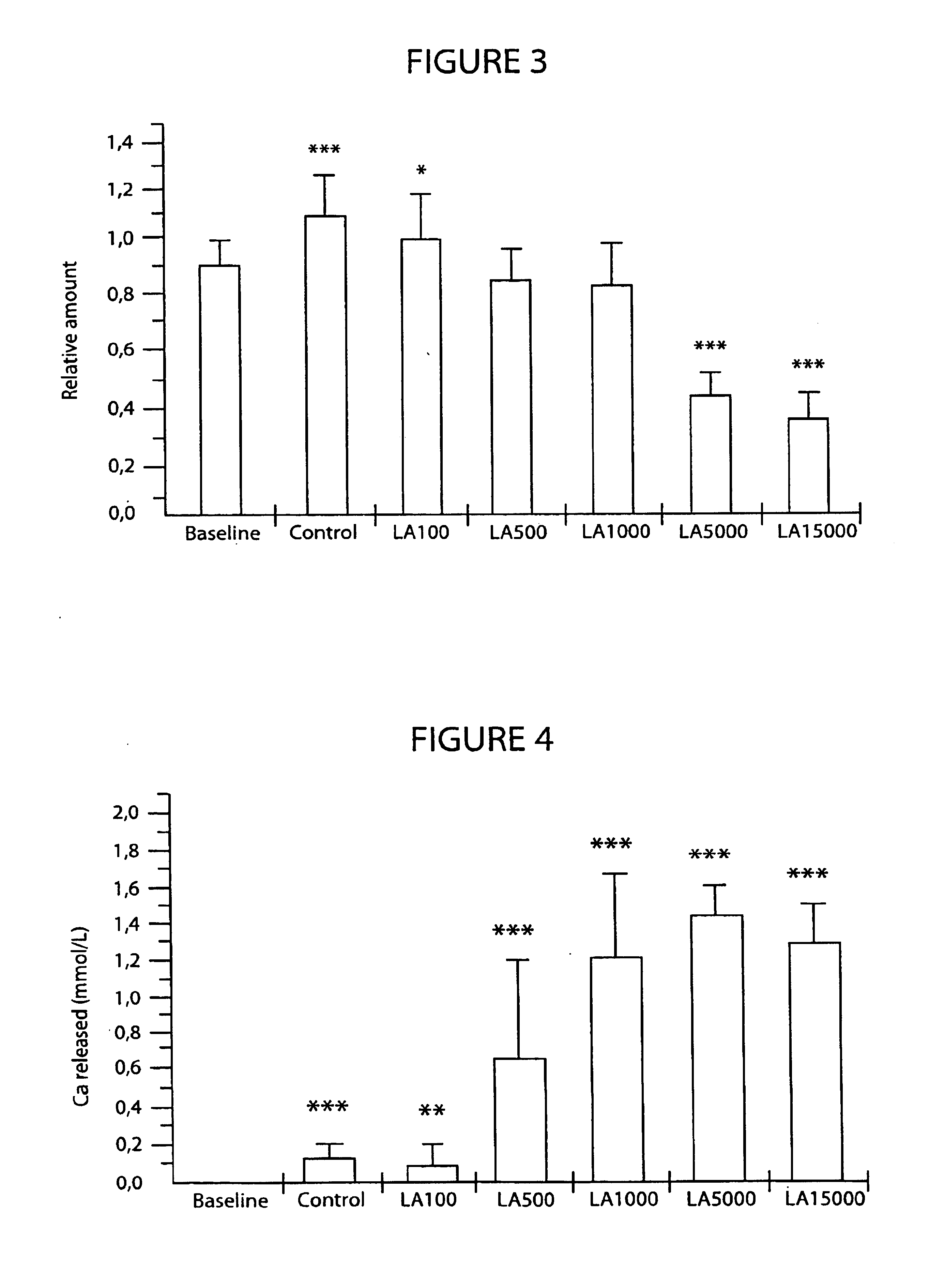Treatment of bone diseases
a bone disease and bone technology, applied in the field of bone diseases, can solve the problems of human bone deficit or human risk of developing a bone deficit, and achieve the effect of enhancing bone formation and bone density, and beneficial to the activity and differentiation of bone cells
- Summary
- Abstract
- Description
- Claims
- Application Information
AI Technical Summary
Benefits of technology
Problems solved by technology
Method used
Image
Examples
example 1
In Vitro Bone Resorption Assay
Test Substance
[0072]The test substance was lanthanum carbonate tetrahydrate (hereinafter lanthanum carbonate). 1 mg of lanthanum is equivalent to 1.9077 mg of lanthanum carbonate. Lanthanum carbonate was dissolved in 2M HCl to give a concentration of 28.6 mg / ml (i.e 15 mg / ml of lanthanum). Aliquots of this stock solution were diluted with 2M HCl to result in solutions of varying concentrations, so that addition of one microliter of these solutions into the culture medium gave the final test concentrations of 100, 500, 1000, 5000 and 15000 ng / ml of lanthanum in culture medium. These solutions / concentrations are hereinafter referred to as LA100, LA500, LA1000, LA5000 and LA15000.
[0073]We used control groups in each assays to show that the assays were capable of detecting the effect of inhibition (bone resorption assay and osteoclast differentiation assay) or activation (osteoblast differentiation and bone formation). The control substanc...
example 2
In Vitro Osteoclast Differentiation Assay
[0107]A method known as mouse bone marrow culture system is the one most widely used to study osteoclast differentiation. Originally, this method was developed by Takahashi et al. (1988a). Osteoclast precursors in mouse bone marrow can be induced to form multinucleated osteoclast-like cells (MNC) in the presence of either an active metabolite of vitamin D3 (1,25(OH)2D3) or parathyroid hormone (PTH). MNC formed in mouse bone marrow cultures have been demonstrated to possess several features characteristic of osteoclasts. They form pits on bone or dentine slices (Takahashi et al. 1988a, Hattersley and Chambers 1989, Shinar et al. 1990); they express high levels of tartrate-resistant acid phosphatase (TRAP) and calcitonin receptors (Takahashi et al. 1988b, Shinar et al. 1990); and they respond to calcitonin (Takahashi et al. 1988a) and prostaglandin E2 (Collins and Chambers 1992). Thus, the method is an ideal one with which to study both stimula...
example 3
In Vitro Osteoblast Differentiation Assay
[0136]Osteoblasts are bone-forming cells which arise from mesenchymal stem cells. During the development of osteoblasts, three distinct periods have been identified and defined: 1) cell proliferation and secretion of extracellular matrix (ECM); 2) ECM maturation; and 3) ECM mineralization. During these periods, a sequential expression of osteoblast phenotype markers has been characterized. Alkaline phosphatase is associated with the bone cell phenotype and is actively expressed during the maturation of the osteoblast. With the onset of mineralization, large amounts of calcium are deposited into the mature organic matrix to form bone-like nodules. By following these markers, we are able to study all the stages of osteoblast differentiation in this culture system.
[0137]Several methods have been devised to study osteoblasts. The first of these involves isolation of cells from calvaria with the osteoblastic phenotype. However, these cells only re...
PUM
| Property | Measurement | Unit |
|---|---|---|
| concentrations | aaaaa | aaaaa |
| concentration | aaaaa | aaaaa |
| concentration | aaaaa | aaaaa |
Abstract
Description
Claims
Application Information
 Login to View More
Login to View More - R&D
- Intellectual Property
- Life Sciences
- Materials
- Tech Scout
- Unparalleled Data Quality
- Higher Quality Content
- 60% Fewer Hallucinations
Browse by: Latest US Patents, China's latest patents, Technical Efficacy Thesaurus, Application Domain, Technology Topic, Popular Technical Reports.
© 2025 PatSnap. All rights reserved.Legal|Privacy policy|Modern Slavery Act Transparency Statement|Sitemap|About US| Contact US: help@patsnap.com


